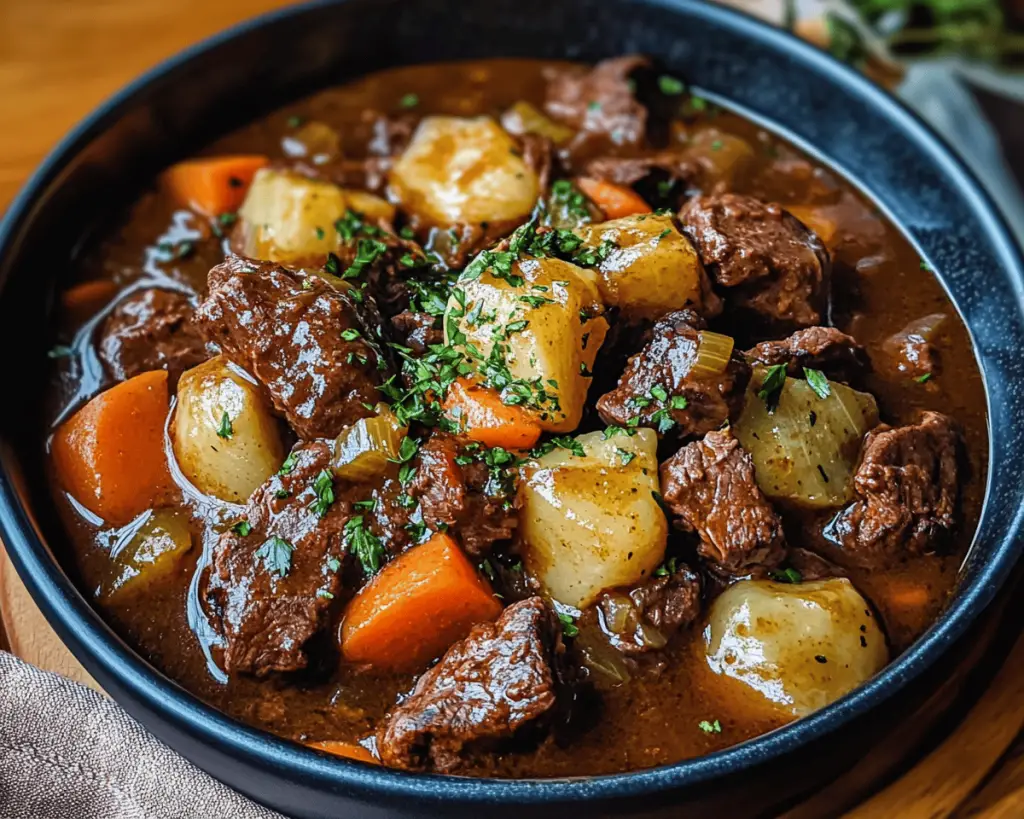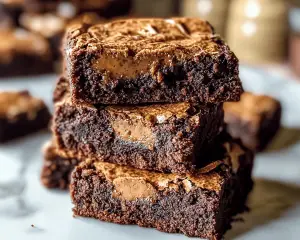There’s something truly special about comfort food, isn’t there? Maybe it’s the warmth it brings to your belly or the memories it can pull from the corners of your mind. For me, nothing embodies that cozy feeling quite like a big pot of **Authentic Belgian Slow-Cooked Beef Stew**. I remember the first time I tried this dish; I was huddled in my older sister’s kitchen on a chilly winter evening. She had a pot simmering on the stove, the kind of aroma that lingers like a warm hug, blending earthy notes of beef, sweet caramelized onions, and rich Belgian ale. It was one of those happy accidents when she was just experimenting with ingredients, and we all fell in love at first bite.
Now, every time I make this stew, I can hear the sound of the rain pattering against the window, see the steam rising from the pot, and feel the joy of sharing a hearty meal with those I love. It’s become part of our family tradition—gathering around the table, bowls piled high, dive into conversations punctuated by laughter. Honestly, if you get it just right, the first taste has this magical ability to transport you back to those moments. Here’s the thing, though: There’s nothing fancy about this recipe. It’s about taking your time, letting the flavors meld together, and, well, enjoying the process. Let me take you on a little journey through my beloved recipe.
What Goes Into Authentic Belgian Slow-Cooked Beef Stew?
Let’s talk ingredients. This is where the magic starts. I think each ingredient tells a story, whether it’s the cut of beef you choose, the ale that you pour in, or the herbs you throw in at the end.
– Chuck Roast: This is my go-to cut. It’s wonderfully marbled which means it breaks down beautifully in the slow cooker. You want to look for good, juicy beef—don’t be shy about asking your butcher for a suggestion if you’re not sure. Don’t skimp here. I usually aim for about 2 to 3 pounds. You want plenty of leftovers, trust me on this.
– Unsalted Butter: Ah, butter—the perfect base for sautéing. There’s something about how it helps the meat caramelize that makes a world of difference. I usually toss in a tablespoon or two because, well, butter makes everything better, right?
– Onions: Yellow onions are the star here. They take on a sweetness once they’re softened and caramelized. I typically use two medium onions. Don’t worry about chopping them perfectly. A rough chop is fine—it’s all going to stew together, after all!
– Garlic: About 4 cloves, minced. Honestly, I might add more because no one should ever skimp on garlic. It adds such depth and flavor.
– Carrots: I love to incorporate bright, vibrant carrots. It adds a sweetness that pairs perfectly with the beef. Usually, I go for about 4 medium-sized carrots, cut into thick rounds—I like them chunky in the stew.
– Celery: To balance the stew and give it that quintessential aromatic flavor, I toss in about 2 to 3 stalks, chopped.
– Beef Broth: You could make your own (kudos to you if you do!) but I usually grab a good-quality carton from the store. About 4 cups should do it.
– Belgian Ale: This is where it gets interesting. A good dark Belgian ale adds depth and richness. If you’re unsure which one to pick, don’t hesitate to ask your local beer shop for a recommendation. I typically go for about 1 to 1.5 cups, depending on how strong I want the beer flavor to be.
– Bay Leaves: A couple of them will infuse that subtle aroma throughout the stew.
– Thyme: Fresh thyme makes all the difference—it’s aromatic and complements the beef so well. I usually toss in a few sprigs.
– Parsley: Lastly, a handful of fresh parsley for garnish. It brightens up the dish and makes me feel French for a moment.
Every time I pick out these ingredients, I’m flooded with memories. Some of my friends have made modifications, throwing in a bit of mushrooms or even parsnips. You know what I mean? It’s about what you love and what feels right for your palate.
Is Authentic Belgian Slow-Cooked Beef Stew Actually Good for You?
Okay, let’s get real. This stew is indulgent, but it’s worth it. While we might not exactly label it as health food, I like to think it’s a hearty and satisfying meal full of nutrients. The beef is a good source of protein, and the carrots and celery add those essential vitamins. Plus, everything cooks down into this rich broth that’s packed with flavor and love.
Now, I wouldn’t necessarily call it “light fare,” but it’s certainly good for the soul. Enjoying this stew after a long day or during a cozy Sunday is a little bit of a ritual. It’s all about balance in life, and I believe that a treat like this now and then does wonders for your spirit!
Here’s What You’ll Need
– 2 to 3 pounds of beef chuck roast
– 2 tablespoons of unsalted butter
– 2 medium yellow onions, roughly chopped
– 4 cloves of garlic, minced
– 4 medium carrots, cut into thick rounds
– 2 to 3 stalks of celery, chopped
– 4 cups of beef broth
– 1 to 1.5 cups of Belgian ale
– 2 bay leaves
– A few sprigs of fresh thyme
– Fresh parsley for garnish
Serves about 6 hearty portions, which is just enough to take the edge off and have some leftovers for the week ahead.
How to Make Authentic Belgian Slow-Cooked Beef Stew Step-by-Step
Now for the fun part—the actual cooking! Let’s dive into it, and as always, feel free to take this at your own pace.
1. **Prep the Meat**: Start by cutting your beef chuck roast into nice, good-sized chunks. About 1.5-inch cubes should work. You want them to be substantial so they hold up and absorb the flavors.
2. **Sear the Meat**: In a large Dutch oven or heavy pot, melt the butter over medium-high heat. When it’s nice and foamy, toss in the beef chunks. You want that beautiful, golden-brown crust. Don’t crowd the pan; do it in batches if you need to. I usually let them sizzle for about 5-7 minutes, turning them halfway through. By the way, this part is messy but the smell is worth it!
3. **Add Onions & Garlic**: Once the beef is gloriously browned, throw in those onions and sauté for another 3-4 minutes until they soften and become translucent. Then add your garlic; you’ll know it’s done when your kitchen starts smelling like heaven.
4. **Stir in Veggies**: Next up, add the carrots and celery. Give it a good stir and cook for an additional few minutes to combine the flavors.
5. **Pour It On**: Now here comes the fun part—pour in your beef broth and Belgian ale. Oh, the glorious sound that comes with it! Scrape up any brown bits stuck to the bottom of the pot—those are flavor bombs.
6. **Season**: Toss in the bay leaves and thyme, then give it a good stir to mix everything together.
7. **Let It Cook**: Cover your pot and bring it to a gentle simmer. Once it’s doing its thing, turn the heat down to low and let it cook. You can also transfer everything to a slow cooker right here if you prefer that method.
8. **Slow and Steady**: Allow the stew to cook low and slow for about 3 to 4 hours. If you can resist, try to wait; the longer it cooks, the better it gets. You’ll know it’s done when the beef is fork-tender and the flavors are harmonious.
9. **Serve It Up**: Remove the bay leaves and thyme sprigs before serving. Ladle the rich stew into bowls, garnishing with fresh parsley on top. I always serve this with some crusty bread for dipping. Because, let’s be honest, you don’t want to waste a single drop.
10. **Enjoy the Magic**: Sit down with your loved ones, share stories, and revel in the moment. That’s what food is really all about.
Little Extras I’ve Learned Along the Way
Sometimes I think cooking is like life—a little improvisation makes all the difference! Here are some tips and variations I’ve gathered over the years while making this stew.
– **Meat Alternatives**: If you want to go a little different, you could try using lamb or pork. I have a cousin who makes a pork version, and it turns out wonderfully too! Just be mindful of the cooking time as different meats can vary.
– **Veggie Forward**: Feel free to sneak in other vegetables. Mushrooms add a lovely umami flavor, or if you have parsnips lying around, toss those in!
– **Herbal Twist**: Don’t be shy with the herbs. I’ve experimented with rosemary and bay leaves together, and it works surprisingly well, making the dish fragrant and delightful.
– **Leftovers Galore**: Honestly, I look forward to the leftovers—even the stew taste better the next day as the flavors have time to dance together in the fridge.
– **Thickening the Stew**: If you want a thicker consistency, mix a tablespoon of cornstarch with cold water and stir that in during the last 30 minutes of cooking.
Cooking is a bit about exploration. Maybe someday you’ll find your version that speaks to your heart just like mine does. You might add a pinch more salt or a splash of vinegar for brightness—whatever resonates with your cooking heart.
This one means a lot to me. There’s magic in the air, and every time I make it, I’m reminded of the love and warmth it brings. If you try this recipe, let me know! I’d love to hear your twist on it, your stories, and what your kitchen experience feels like. Happy cooking!



